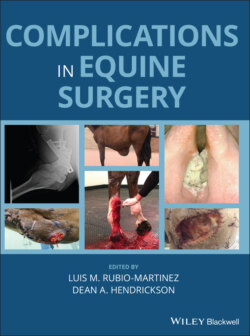Читать книгу Complications in Equine Surgery - Группа авторов - Страница 122
Pathogenesis Infection
ОглавлениеAll sutures produce a local tissue reaction to some degree, which increases the susceptibility to development of an incisional infection [4]. Infection can be the primary reason causing dehiscence or can be a sequelae to dehiscence [5]. Bacteria release proteolytic enzymes that inhibit wound healing, therefore inducing wound disruption and dehiscence [5].
Tissue integrity and perfusion, local wound repair responses, and bacterial challenge, influence the presence of an infection of the suture line [6].
Degree of bacterial contamination is a useful predictor of incisional/wound infection potential [7].
Improper wound cleansing with cytotoxic substances or overzealous scrubbing can result in unnecessary tissue inflammation, edema, and necrosis, all leading to an increased risk of incisional infection and dehiscence [8].
Inadequate or traumatic debridement of necrotic, devitalized, heavily contaminated tissue and organic debris increases risk of incisional infection and dehiscence.
Use of a larger suture size than necessary results in unnecessary foreign material present within the wound/incision, altering the tissue structure, weakening the repair, and therefore decreasing the capacity to resist infection [3, 9]. Physical and biochemical characteristics of the suture serve as an important factor in the initiation, severity, and persistence of incisional infections [4]. Bacteria have a higher affinity for braided suture compared to monofilament suture [4]. Removal of bacteria by the body’s defense mechanism is slower with braided suture [4]. The use of barbed sutures has been shown to increase the risk of incisional infections [10],
Suture pattern choice can contribute to prolonged edema and erythema from decrease in microvascular flow, resulting in delayed healing, decreased incisional tensile strength, and risk of incisional complications [11].
